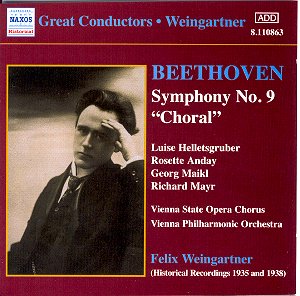Though it emerged as much by default as by design
Weingartner’s is still one of the most musically recommendable
of all cycles of the Beethoven Symphonies. His sagacity in matters
of balance, rhythm and tempo relation are as notable now as when
Weingartner set down these recordings. Quite unselfconscious in
matters of phrasing, with a determining impetus, few have sounded
less sentimental or more nobly grave. And when we arrive at the
Ninth one finds utterly undimmed his sense of clear-eyed mobility
allied to expressive depth. His control of the first movement
is absolute, imagination and clarity held in perfect accord, adopting
a tempo which whilst subject to a little flexibility is nevertheless
essentially one of logic and phrasal sensitivity. What one appreciates
more and more is his control of the long line, his avoidance of
show and gesture, of the superficial and passing. There is a refusal
to indulge metricality, his austere nobility of utterance is one
that would regard speed for its own sake not simply as a crude
imposition but, worse, as musical solipsism.
The Molto Vivace finds the Vienna fiddles on
fine, slashing form and the woodwind principals add their own
distinctive colours to the patina – the bassoonist and oboist
are especially characterful. The phrasing in the slow movement
conforms to everything we know of Weingartner’s supple gravity,
with the exceptionally fine violin line, the incision of the pizzicati
and horn playing adding even greater riches. The string cantilena
unfolds in a single unbroken span. The sepulchral basses makes
their unmistakable presence felt in the recitative of the last
movement in which Weingartner binds the syntax with a command
that never becomes slack. The finale is in fact notable for his
eagle-like vision in which one constantly feels oneself in the
presence of a control both lateral and vertical. The Chorus is
virile even if unpredictable – note writer Ian Julier rightly
cites the tenors’ occasional imperfections – but the quartet of
soloists includes the venerable bass Richard Mayr. The early Presto
section isn’t quite secure but by the Maestoso we are witnessing
a gripping intensity and the blazing cry of triumph in the Allegro
energico is really something. All this is possible because of
Weingartner’s heroic concentration
Coupled with the Ninth is The Consecration of
the House Overture, which receives a crisp and well-judged reading,
full of rhythmic drive and sectionally very well balanced. The
Columbia LXs had a good, wide frequency range that has been well
captured by Mark Obert-Thorn. It’s just and apposite that Naxos
has used a photograph of the young Weingartner, after the venerable
artwork of their previous issues in this series. For me his Beethoven
cycle will remain perennially sagacious, a compound of youth and
wisdom.
Jonathan Woolf
